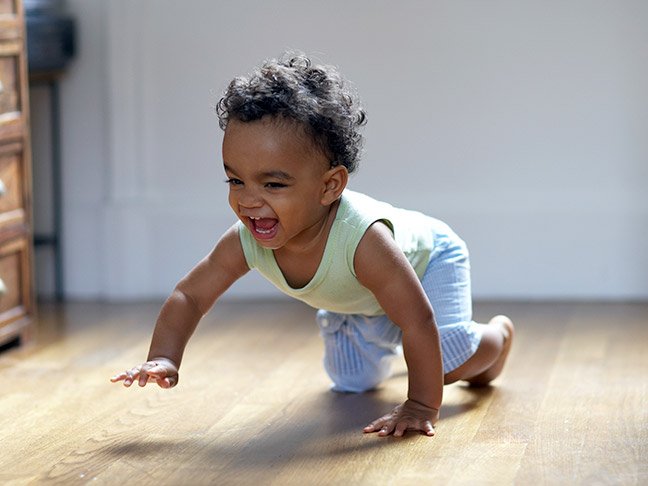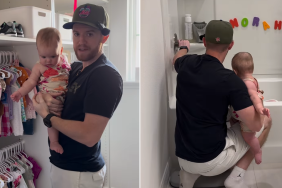When do babies crawl? Crawling is your baby’s first method of getting from here to there independently. It’s an exciting milestone for your baby, who no longer has to sit back and watch others move around with ease and can finally get in on the action.
The traditional crawl involves balancing on hands and knees first, then learning to push forward and backward to initiate movement. In doing this, your baby not only learns to move around, but she also prepares her muscles for the next step: walking.
It’s important to note that not all babies start crawling at the same time or the same way. In fact, some babies never quite adapt to that traditional crawl as they find other methods of efficient movement around the house!
At what age do babies crawl?
Most babies begin to crawl anywhere between 7 and 10 months. Babies grow and develop on their own timelines, so don’t become overly alarmed if your 10-month-old isn’t moving just yet.
Many babies create their own methods of getting around before they begin the traditional crawl. Some are content to roll from place to place, while others might slither on their bellies using their arms to speed up the process. Many babies use a form of scooting (shuffling around on their bottoms using one hand behind and a one foot in front to move forward.)
The style or method of movement your baby uses isn’t important; it’s learning to use their arm and leg muscles together for balance and movement that matters most. Resist the urge to correct the style and give your baby the time and space to practice.
How do babies learn to crawl?
Babies don’t need tumbling classes to learn how to crawl, they simply need time on the floor. Believe it or not, the first step in learning to crawl is sitting upright without assistance. Somewhere around 8 months, you’ll notice that your baby is using her neck, back, arm, and leg muscles to sit up on her own. Your baby engages all of these muscles when she learns to crawl, so making sure she has plenty of time to sit and explore on her own is important.
Shortly after she masters sitting, your baby will begin reaching for objects. When she does this, she’ll figure out that she can balance on her hands to stretch her muscles a little further. She might even rock back and forth a bit to test her theory. From there, she’ll practice pushing up or forward, and learn to right herself when she loses her balance. By about 9 or 10 months, she’ll see that pushing forward onto her knees helps her move forward. Then, she’s off!
How can I promote crawling?
• Tummy time is a must! Long before your baby even considers mobility, she needs to develop her muscles. Tummy time gives your baby the opportunity to build her neck, back, arm, and leg muscles. Place your baby on her belly and play with her a few times a day.
• Place toys and interesting things just out of reach. It’s a natural reaction to hand over the toy your baby is reaching for to help reduce frustration, but this actually discourages babies from exploring that wonderful area just out of reach. In providing encouragement for babies to reach for coveted items, parents help babies learn to balance using their arms and move forward.
• Create a safe crawling space. When your baby shows signs of movement, it’s time to baby proof. Instead of feeling anxious about every obstacle and stopping your baby from exploring certain areas, get down on your hands and knees and take a look at your living space from your baby’s perspective. In doing this, you can spot the places that need baby proofing, like tables with hard corners and outlets.
What if my baby doesn’t start to crawl?
While most babies are crawling proficiently by their first birthday, some are slow to move. Child development doesn’t follow a specific guideline. If your baby isn’t showing any signs of movement (rolling, creeping, slithering, scooting), and she hasn’t figured out how to use her arms and legs together yet by the time she turns 1, mention your concerns at her well baby visit. Keep in mind that premature babies might meet milestones later, and some babies skip over the rocking and scooting and head straight to traditional crawling later on.
Photo: Getty








